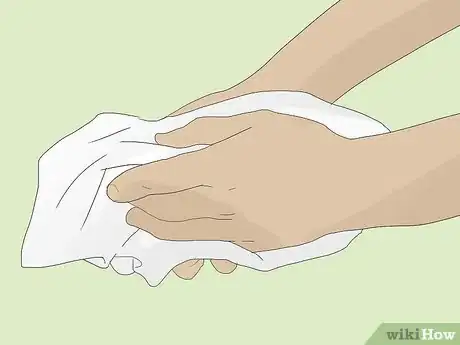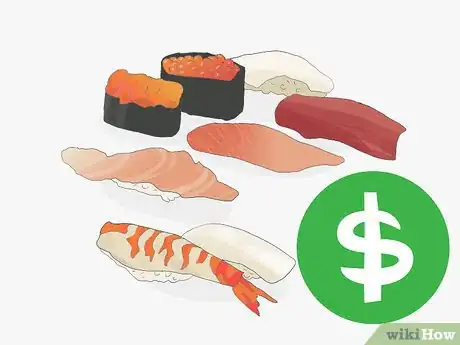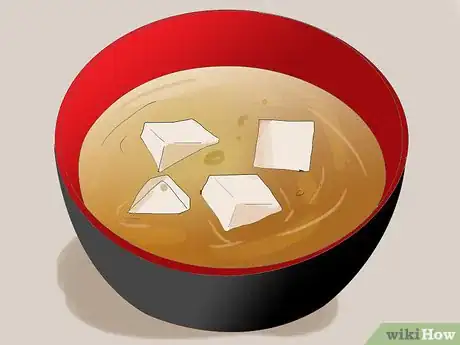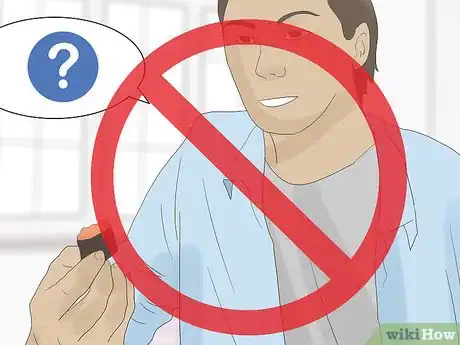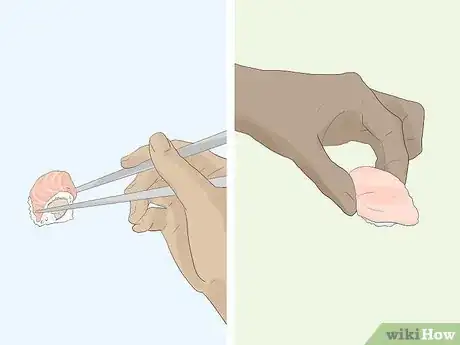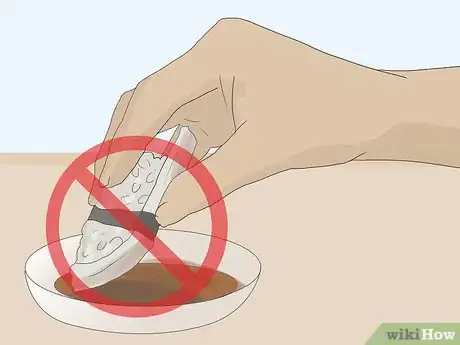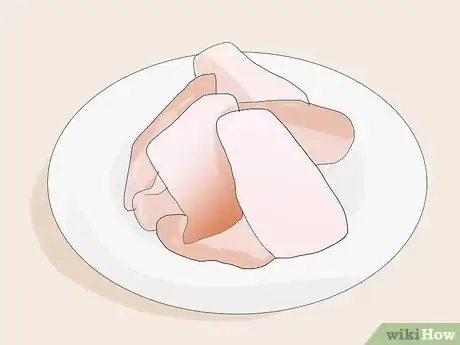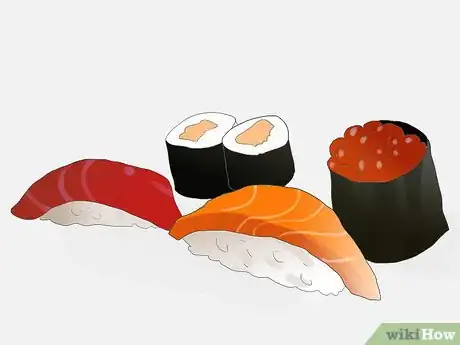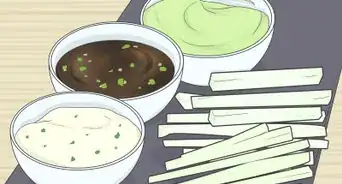This article was co-authored by Daniel Siriban. Daniel Siriban is a Japanese Personal Chef and the Owner of Roshi Experience. With over 18 years of culinary experience, he specializes in sushi, teppanyaki, and traditional Japanese dining. Daniel holds an AA in Restaurant, Culinary, and Catering Management from The Art Institute of California, Orange County.
There are 15 references cited in this article, which can be found at the bottom of the page.
This article has been viewed 34,461 times.
Omakase means “to trust” in Japanese. When you order omakase, you put your trust in the sushi chef to serve you something tasty.[1] You might get nigiri (rectangular pieces of rice topped with raw fish), sushi rolls (a short tube of seaweed filled with rice and raw fish), or sashimi (raw fish). Ordering and eating omakase is fun and easy, and since you never know what you're going to get, you're always in for a great surprise!
Steps
Preparing to Eat Omakase
-
1Make a reservation. You might want to make a reservation before arriving at a sushi restaurant, especially if it's not a chain restaurant. If you decide to make a reservation, be sure to show up -- some restaurants will charge you the price of a meal if you don't show up.[2]
- There's no right or wrong time to make a reservation. However, the further ahead you make your reservation, the more likely you are to eat omakase when you want.
-
2Don't wear perfume. If you apply perfume or cologne, you'll disrupt your ability to appreciate the scent and flavor of the fish in your omakase. And in a small sushi restaurant, you might ruin the experience of others, too.[3]Advertisement
-
3Decide where you want to sit. You'll often have the option of being seated in the general seating area or at the sushi bar. If you sit at the sushi bar, you'll be able to watch the sushi chef work, and might get to interact with them a bit. If you prefer to be left alone while waiting for your sushi to arrive, you can sit in the general seating area.[4]
- There is no right or wrong choice when deciding where to sit.
-
4Wipe your hands before eating. In some sushi restaurants, you'll be offered a warm, damp towel before your meal. Wipe your hands with it, then fold it neatly on the tray it was delivered on.[5]
- You can use this towel as a napkin during the meal, wiping your hands off on it between pieces of sushi.[6]
Placing Your Order
-
1Decide how much you want to spend. There are three levels of omakase. You could select nami (standard), jo (premium), or toku-jo (extra-premium). The nami will have the least extravagant ingredients. The toku-jo will be the most expensive. There is no right or wrong way to decide how much you want to spend -- just make sure you can afford whatever you choose.[7]
-
2Inform the chef of your dietary preferences. If you have allergies or particular dietary preferences, let your chef know ahead of time. That way, they'll be able to create an omakase sushi course that you can eat and enjoy safely.[8]
-
3Request miso soup after the omakase. Miso soup usually comes with an omakase meal, and is meant to help settle your stomach after you've eaten. But in some countries, miso soup is served before the omakase. Ask your waiter or waitress to bring your miso soup only after you've finished your omakase.[9]
Enjoying the Omakase Course
-
1Don't ask questions before eating. Sushi chefs want you to enjoy the experience of eating their unique sushi without preconceptions. Respect the chef's decisions regarding the food items used.[10] When enjoying an omakase course, reserve questions about the content of a particular piece of sushi until after you've eaten it.[11]
-
2Pick up the sushi with your hand or chopsticks. When you're ready to eat the sushi, pick it up with either your left or right hand. Then push the whole piece of sushi into your mouth. Alternately, pick the sushi up with chopsticks and place it in your mouth.[12]
- The choice to use one or the other is entirely a matter of personal preference. However, it can be difficult to dip nigiri in soy sauce using your chopsticks, since custom dictates that you dip it upside down (that is, with the fish on the bottom).
- Using your hand is also advantageous because it reduces the likelihood that the sushi rice will crumble or fall apart completely as you eat.[13]
-
3Don't use soy sauce. Many sushi chefs will be insulted if they see diners using soy sauce on their sushi. Therefore, it's best to enjoy your omakase sushi without soy sauce.[14]
- At finer restaurants, the chef will apply the soy sauce themselves so you don't have to.
- If your chef doesn't add soy sauce to a dish, you can add some yourself. Pour only 1/4 teaspoon or so into the shallow dish provided by the restaurant, then dip (but don't dunk) one edge or corner of the fish (not the rice) into the soy sauce.[15]
- If you're eating a sushi roll, it is not possible to dip the fish without dipping the rice, so just dip one edge of the roll into the soy sauce. Alternately, dip a piece of ginger into the soy sauce and lightly brush the roll with it.
-
4Eat the sushi as soon as possible. The sushi chef controls the pace of the omakase course, and will serve the sushi at an an appropriate time and temperature. When the chef offers you a new plate of sushi, you should begin eating immediately. There's no need to rush, but you should not wait to begin eating the freshly prepared sushi, either.[16]
-
5Eat the sushi in one bite. It's considered rude to eat sushi in multiple bites. Plus, biting into a piece of sushi will cause it to fall apart, making the remnant difficult to eat.[17]
- If, after eating a particular piece of omakase sushi, you find that it was too large to eat in a single bite, ask the chef to craft slightly smaller pieces for the next round.
- Alternately, you could ask the chef to cut a large piece in half.
-
6Eat a slice of ginger after eating a piece of sushi. Pickled ginger is always provided alongside your sushi. After eating a piece of omakase sushi, eat a piece of ginger to cleanse your palate.[18]
- Don't use the ginger as a topping for your sushi during the omakase course.
-
7Use wasabi only with sashimi. Wasabi -- a spicy Japanese horseradish -- can be mixed into soy sauce if you're eating sashimi (a slice of raw fish slice without rice). Other types of sushi already have wasabi applied to them by the sushi chef, who will frown upon any attempt to alter what they consider an already perfect sushi creation.[19]
- There is no right or wrong amount of wasabi to mix into your soy sauce. However, keep in mind that a little goes a long way! Add a small amount to your soy sauce, then add more as needed.
-
8Order more of a preferred item. If one of the omakase sushi items was especially delicious, feel free to order another of that particular kind. Your sushi chef will be happy to know that they accurately gauged your preferences.[20]
Expert Q&A
-
QuestionWhy is omakase so expensive?
 Daniel SiribanDaniel Siriban is a Japanese Personal Chef and the Owner of Roshi Experience. With over 18 years of culinary experience, he specializes in sushi, teppanyaki, and traditional Japanese dining. Daniel holds an AA in Restaurant, Culinary, and Catering Management from The Art Institute of California, Orange County.
Daniel SiribanDaniel Siriban is a Japanese Personal Chef and the Owner of Roshi Experience. With over 18 years of culinary experience, he specializes in sushi, teppanyaki, and traditional Japanese dining. Daniel holds an AA in Restaurant, Culinary, and Catering Management from The Art Institute of California, Orange County.
Japanese Personal Chef When you order omakase, you encourage the chef to bing up the freshest and best ingredientes, giving them creativity to work without boundaries, which is usually more expensive.
When you order omakase, you encourage the chef to bing up the freshest and best ingredientes, giving them creativity to work without boundaries, which is usually more expensive. -
QuestionIs mixing wasabi and soy sauce rude?
 Daniel SiribanDaniel Siriban is a Japanese Personal Chef and the Owner of Roshi Experience. With over 18 years of culinary experience, he specializes in sushi, teppanyaki, and traditional Japanese dining. Daniel holds an AA in Restaurant, Culinary, and Catering Management from The Art Institute of California, Orange County.
Daniel SiribanDaniel Siriban is a Japanese Personal Chef and the Owner of Roshi Experience. With over 18 years of culinary experience, he specializes in sushi, teppanyaki, and traditional Japanese dining. Daniel holds an AA in Restaurant, Culinary, and Catering Management from The Art Institute of California, Orange County.
Japanese Personal Chef Yes, it is. Usually, the wasabi is already integrated into the served sushis, so there's no need to mix it.
Yes, it is. Usually, the wasabi is already integrated into the served sushis, so there's no need to mix it. -
QuestionAre you supposed to dip sushi in soy sauce?
 Daniel SiribanDaniel Siriban is a Japanese Personal Chef and the Owner of Roshi Experience. With over 18 years of culinary experience, he specializes in sushi, teppanyaki, and traditional Japanese dining. Daniel holds an AA in Restaurant, Culinary, and Catering Management from The Art Institute of California, Orange County.
Daniel SiribanDaniel Siriban is a Japanese Personal Chef and the Owner of Roshi Experience. With over 18 years of culinary experience, he specializes in sushi, teppanyaki, and traditional Japanese dining. Daniel holds an AA in Restaurant, Culinary, and Catering Management from The Art Institute of California, Orange County.
Japanese Personal Chef You can if you want. Remember, though, to Always put the fish in the soy sauce, not the rice.
You can if you want. Remember, though, to Always put the fish in the soy sauce, not the rice.
References
- ↑ Daniel Siriban. Japanese Personal Chef. Expert Interview. 1 September 2021.
- ↑ https://gurunavi.com/en/japanfoodie/2015/10/sushi-etiquette-tips.html?__ngt__=TT0d61fe75e005ac1e4ae4a4XL7kEyxkzuFIBVh5TmC2w5
- ↑ https://gurunavi.com/en/japanfoodie/2015/10/sushi-etiquette-tips.html?__ngt__=TT0d61fe75e005ac1e4ae4a4XL7kEyxkzuFIBVh5TmC2w5
- ↑ http://www.sushifaq.com/basic-sushi-experience-information/how-to-eat-sushi-sushi-etiquette/
- ↑ http://www.sushifaq.com/basic-sushi-experience-information/how-to-eat-sushi-sushi-etiquette/
- ↑ http://www.cnn.com/travel/article/how-to-eat-sushi/index.html
- ↑ http://www.savoryjapan.com/recipes/sushi/sushi.etiquette.html
- ↑ https://gurunavi.com/en/japanfoodie/2015/10/sushi-etiquette-tips.html?__ngt__=TT0d61fe75e005ac1e4ae4a4XL7kEyxkzuFIBVh5TmC2w5
- ↑ http://www.latimes.com/food/dailydish/la-dd-sushi-sins-20160319-htmlstory.html
- ↑ Daniel Siriban. Japanese Personal Chef. Expert Interview. 1 September 2021.
- ↑ https://www.groupon.com/articles/omakase-with-sushi-chef-sushi-mike
- ↑ https://gurunavi.com/en/japanfoodie/2015/10/sushi-etiquette-tips.html?__ngt__=TT0d61fe75e005ac1e4ae4a4XL7kEyxkzuFIBVh5TmC2w5
- ↑ http://www.cnn.com/travel/article/how-to-eat-sushi/index.html
- ↑ http://www.foodrepublic.com/2014/04/21/interview-with-a-sushi-god-chef-seki-on-etiquette-soy-sauce-usage/
- ↑ http://www.latimes.com/food/dailydish/la-dd-tokyo-sushi-chef-proper-way-eat-sushi-20140828-story.html
- ↑ https://gurunavi.com/en/japanfoodie/2015/10/sushi-etiquette-tips.html?__ngt__=TT0d61fe75e005ac1e4ae4a4XL7kEyxkzuFIBVh5TmC2w5
- ↑ https://gurunavi.com/en/japanfoodie/2015/10/sushi-etiquette-tips.html?__ngt__=TT0d61fe75e005ac1e4ae4a4XL7kEyxkzuFIBVh5TmC2w5
- ↑ http://www.latimes.com/food/dailydish/la-dd-tokyo-sushi-chef-proper-way-eat-sushi-20140828-story.html
- ↑ http://www.cnn.com/travel/article/how-to-eat-sushi/index.html
- ↑ http://www.savoryjapan.com/recipes/sushi/sushi.etiquette.html




